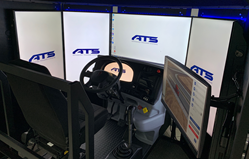Recent research from Brandon Hall Group shows that the use of virtual reality (VR) as a training modality is growing rapidly in “high-consequence” industries—those in which operator mistakes can cause significant property damage or fatalities or both. According to the study, nearly a third of surveyed companies in such industries identified VR tools as a top learning priority over the next 24 months—a 60% increase over two years.1

Image credit: Advanced Training Systems
“We’re definitely seeing that in the motor freight industry,” says John Kearney, CEO, Advanced Training Systems LLC. Kearney, whose company is a leading designer and manufacturer of virtual simulators for driver training, among other applications, adds, “Trucking companies, driving schools, and the general public are increasingly aware that simulation training—that is to say, virtual reality—helps produce drivers who are better prepared to deal with any situation they might encounter.”
Simulation, says Kearney, solves a classic training dilemma: how do you safely prepare trainees to deal with dangerous or extraordinary situations? Once dismissed as a toy, VR has been objectively shown to offer measurable improvement in the performance of tasks as disparate as flying advanced jets and handling dangerous chemicals.2 This, Kearney notes, makes it a natural for truck drivers. The Department of Labor’s Bureau of Labor Statistics, cites vehicle crashes as the leading cause of workplace deaths in the United States. Over 90% of such accidents, according to the National Highway Safety Administration, are at least partly due to driver error.3 Training with simulators is relatively new to the trucking industry compared to other professions and Kearney’s firm has been at the forefront of advocating for simulation to be a training standard among the trucking industry for years. “Pilots are required to train via simulation—professional truck drivers should too. With all the high technology, this is a new era of CDLs.”
In addition to enhancing driver safety performance, simulation, by reducing the required amount of on-the-road training students must spend with a single instructor, and expediting instruction success, is helping attract more women to the truck driving field. Advanced Training Systems helped Fox Business report on the Women in Trucking story in December 2019. According to the American Trucking Associations, the number of women truckers in the U.S. has increased by about a third since 2003.4 Through community college-based commercial driver’s license programs, which increasingly include simulator training, the industry is also actively recruiting new drivers from the ranks of industries where employment is sagging, such as laid-off miners in Appalachia.5
Beyond reduced training cost and improved safety preparedness, notes Kearney, simulation offers long-term financial benefits to trucking companies. A trainer for an oilfield service company in Texas, for example, says simulator training has resulted in both fewer rollovers and fewer overall accidents. A Canadian bulk commodity hauler reports that by teaching correct driving technique, simulation training has reduced the company’s fuel cost by an average of 30%.6
“All in all,” says Kearney, “simulation training is doing two important things for trucking. First, it is producing better-trained, safer, and more cost-effective drivers. Second, by helping open trucking to people who might not previously have considered it as a profession, it is providing at least a partial solution to a chronic driver shortage.”
- Wentworth, David, “The Impact and Potential of Virtual Reality Training in High-Consequence Industries,” Training, January 25, 2018.
- DeMarinis, Tony, et al., “Real learning in a virtual world,” Deloitte, August 14, 2018.
- Pettegrew, Jeff, “Self-driving trucks take the road in Texas. How will workers be impacted?”, Property/Casualty 360°, September 17, 2019.
- Lopez, Frank, “Women in Trucking: Making Roads Safer,” Business Journal, October 9, 2019.
- Pergrem, Madison, “Truck driver shortage gives opportunities to people in the region”, WMYC News, Letcher County, KY, December 12, 2019.
- Wickenhauser, Dave, “Simulator use is catching on for schools, carriers,” Trucking Truth, April 28, 2019.
